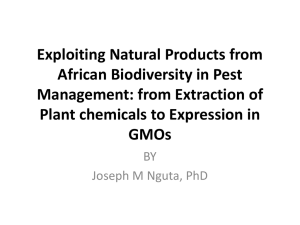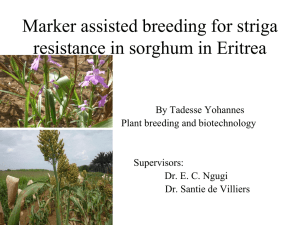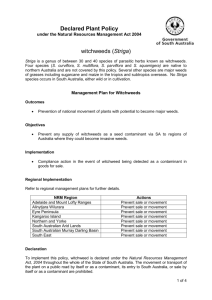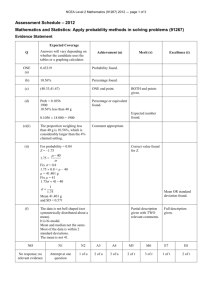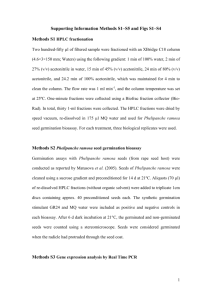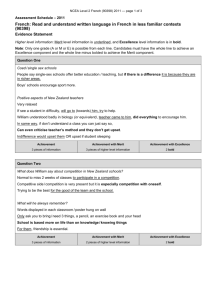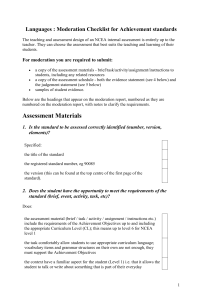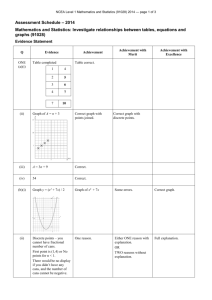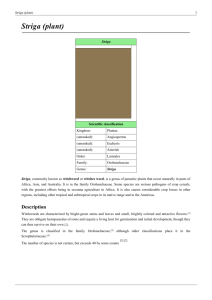91603 Sample Assessment Schedule
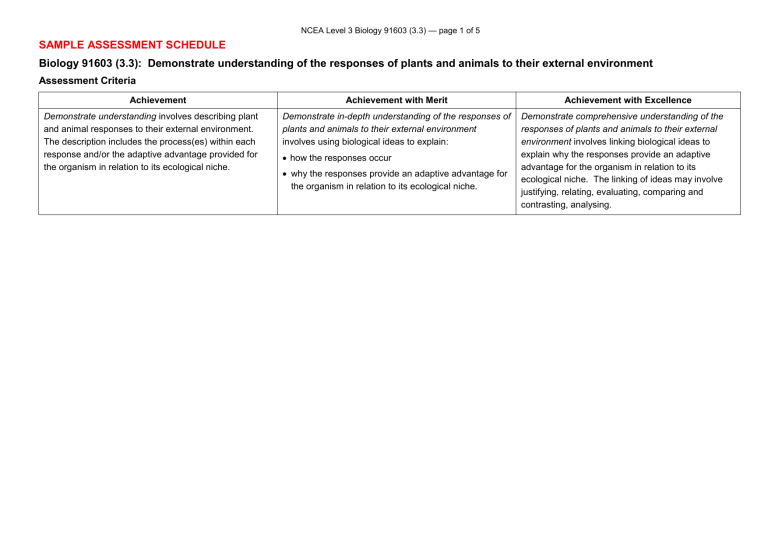
NCEA Level 3 Biology 91603 (3.3) — page 1 of 5
SAMPLE ASSESSMENT SCHEDULE
Biology 91603 (3.3): Demonstrate understanding of the responses of plants and animals to their external environment
Assessment Criteria
Achievement
Demonstrate understanding involves describing plant and animal responses to their external environment.
The description includes the process(es) within each response and/or the adaptive advantage provided for the organism in relation to its ecological niche.
Achievement with Merit
Demonstrate in-depth understanding of the responses of plants and animals to their external environment involves using biological ideas to explain:
how the responses occur
why the responses provide an adaptive advantage for the organism in relation to its ecological niche.
Achievement with Excellence
Demonstrate comprehensive understanding of the responses of plants and animals to their external environment involves linking biological ideas to explain why the responses provide an adaptive advantage for the organism in relation to its ecological niche. The linking of ideas may involve justifying, relating, evaluating, comparing and contrasting, analysing.
NCEA Level 3 Biology 91603 (3.3) — page 2 of 5
Evidence Statement
One
(a)
(b)
Expected Coverage
The relationship between Striga and its host is exploitation or parasitism.
Striga seeds remain dormant in the soil until induced to germinate by the presence of a host plant. They germinate and grow towards the host plant
(chemotropism) where they must attach within 96 hours. They use the resources of the host plant to grow and reproduce / produce seeds.
Because it is able to utilise the resources of its host plant to gain water, support and Nitrogen, Striga is able to survive in low Nitrogen soils while still getting the nutrients needed to reproduce, etc.
As Striga grows, it draws more resources away from the host plant and will affect growth of the host plant, eventually reducing crop production. In the long-term: crops, in poor soils especially, will reduce, which will in turn, affect growth and survival of Striga too OR
Striga seed build up over seasons will have an increasingly detrimental effect
Injection of ethylene gas into the ground acts as a controlling agent as it mimics the chemical attractant released by a host plant and triggers germination in dormant Striga seeds present in the soil. The Striga will germinate, but without a host plant to attach to cannot gain sufficient nutrients and so will not survive.
Hence the all of the Striga is destroyed.
NØ
No response; no relevant answer.
N1
ONE
Achievement point (or TWO partial).
N2
TWO Achievement points (or THREE partial).
Achievement
Candidate identifies that:
the relationship as parasitic or exploitation
Striga uses the resources of the host plant to survive
Striga affects the growth / development / fitness of the host plant
Striga germinates in the soil when a host plant is near
Striga seeds will germinate in the presence of ethylene gas but will die if host not present
Merit
Candidate explains:
that Striga uses / parasitises its host for water / support AND
Nitrogen (or by clear implication)
that the Striga is advantaged by producing many seeds, which remain dormant as they can wait until a host plant is available, increasing survival.
that host has less energy for reproduction/food production/ yield decreases ( not just “fails,
“detrimental”, etc )
that ethylene will cause Striga to germinate even if a host is not present , and so can remove seeds, controlling
Striga.
A3
THREE
Achieveme nt points.
A4
FOUR Achievement points (or ONE Merit point and TWO
Achieved).
M5
TWO Merit points.
M6
THREE Merit points.
Excellence
Candidate comprehensively explains:
the parasitic relationship
AND explains what Striga gains from the host plant in terms of survival advantage
how Striga’s method of reproduction assists its survival and reproduction
the long term effect of
Striga on crop production, in terms of nutrient loss, competition and / or other long term effects
the biology behind the controlling of Striga using ethylene gas, i.e. stimulation, germination, unable to get nutrients, dies, therefore cleared
E7
TWO
Excellence points.
E8
THREE
Excellence points.
Two
(a)
(b)
The migratory behaviour of E7 is genetically programmed and therefore the bird has no control over the instinctive urge to migrate, inherited over thousands of years.
Survival should be enhanced through better food supplies and longer feeding periods, which results in healthier young and a higher survival rate.
E7 will most likely navigate using sun and star compasses across the ocean, as landmarks will not be available. It will adjust its sun compass for changes in latitude and direction as it flies North West.
E7 may also use the effect of polarisation of light to maintain its direction. On reaching the coast of China, E7 will most likely pick up landmarks to identify a change in direction, which will be in a north to north east direction towards Alaska.
A reason why migratory numbers have dropped since 1999 could be due to changes in the migratory route which have impacted on survival of the birds, such as the part that crosses over mainland
China. Staging sites may have been lost due to environmental changes or human impact. Predators including humans may be attacking the birds. Also the nesting sites themselves may have reduced or become less hospitable due to more recent changes, with reduced food supplies, impacting on survival.
NCEA Level 3 Biology 91603 (3.3) — page 3 of 5
Expected Coverage
Laying down fat stores increases stored energy for a lengthy journey and fat is lighter, so it is a more efficient storage of energy for flight.
Awaiting suitable wind currents will assist birds to get underway and save some energy, as birds will not be going against the wind current. The bird could be harmed at the start of the journey fighting against a cross current. easier
Achievement
Candidate indicates that:
stored fat supplies will provide energy needed for migration
OR flying with the wind currents will save the bird energy / will be
Merit
Candidate explains:
how both of the behaviours assist the bird before migration
migration sites will provide more food supplies/resources to feed the young OR migration sites will provide more hours of light to feed in
(not just “better”, etc)
migration will be by sun / star compass across the ocean OR migration across China / change in direction described as due to landmarks
a realistic and viable reason for loss of numbers since 1999 is given, e.g. increase in
(introduced) predators
the nature of migratory behaviour as being genetically programmed
the reproductive/ survival advantages of migration to E7 the methods of navigation, i.e. day vs night or explains mechanism
justifies a reason for the fall in migratory numbers since
1999, e.g. predators attacking eggs, reducing pop. size
NØ N1 N2 A3 A4 M5 M6
Excellence
Candidate comprehensively explains:
the nature of migratory behaviour and its genetic basis
the reproductive advantages and consequences of migratory behaviour, e.g. more/ healthier offspring
with justification, most likely methods of navigation which link to the migratory route shown in the map
possible reasons for the fall in migratory numbers since 1999 and discusses the justification.
E7 E8
No response; no relevant answer.
ONE partial point. ONE Achievement point (or TWO partial).
TWO
Achievement points.
THREE
Achievement points.
TWO
Merit points.
THREE
Merit points.
TWO
Excellence points.
THREE
Excellence points.
Three
(a)
(b)
Expected Coverage
The rhythmic pattern is circa-annual and is endogenous because it happens on a regular basis, once per year at the same time, under the same conditions. Exactly when is controlled by the lunar cycle, which is effectively controlling the light intensity.
If the rhythm were exogenous it would happen at any time of the year and not at the same time each year.
NCEA Level 3 Biology 91603 (3.3) — page 4 of 5
Achievement
Candidate describes:
endogenous rhythm OR role of lunar cycle,
Merit
Candidate explains:
rhythm is genetically/internally controlled but may be triggered by external stimuli
Large numbers of gametes are released (an r- strategy) so that there are increased chances that reproduction will happen and some offspring will survive.
Darkness provides some protection from predators. Those
Palolo with the ability to entrain in this way are the ones that have successfully reproduced, so the particular biological clock has been passed on.
Adaptive advantages for the Palolo worm are that all gametes are released at the same time so reproduction is synchronised.
By synchronising with the new moon and low tide the Palolo ensure gametes gain some protection from predators due to darkness and that they should not be carried into shore.
Survival costs are that the offspring receive no parental care or protection. Should conditions change, the offspring being produced at the same time could be heavily predated or harmed by adverse conditions, reducing survival chances.
Predators could have co-evolved to predate Palolo worms.
r-strategy reproductive behaviour of Palolo – i.e. many gametes released
synchronisation increased fertilization/ offspring OR darkness provides some protection for gametes/ offspring OR no parental care reduces energy used
many gametes/ offspring killed OR annual breeding depends on good conditions
adaptive advantages of
Palo lo’s reproductive behaviour
explains survival costs to Palolo due to its reproductive behaviour
Candidate comprehensively explains:
Excellence
BOTH adaptive advantages
AND survival costs due to the rhythmic nature of its behaviour.
A justification for the use of the reproductive strategy.
NØ N1 N2 A3 A4 M5 M6 E7 E8
No response; no relevant answer.
ONE partial point.
ONE Achievement point
(or TWO partial).
TWO
Achievement points OR
ONE Merit
THREE
Achievement points OR
A+M.
TWO Merit points.
THREE
Merit points.
ONE
Excellence point covered.
TWO
Excellence points.
Four
(a)
(b)
NCEA Level 3 Biology 91603 (3.3) — page 5 of 5
Expected Coverage
A taxis is where an animal moves away or towards a directional stimulus. The maggot’s behaviour is a negative phototaxis because it is a movement away from the light stimulus detected by different receptors. The barnacle behaviour is a positive chemotaxis. In this case the larva detects and moves towards the chemical, showing a positive response. On detecting the rocky environment its cement glands attach it to the rock. This is a thigmokinesis, as the attachment is as soon as the rock is touched (there is no change in rock intensity).
The ecological niche of the maggot is moist and dark, with a food supply for growth and development into an adult.
For the maggot an adaptive advantage is that it can avoid light and possible desiccation or predation, but also it can locate dark places, which is likely to be where its food supply is (inside moist bodies).
The ecological niche of the barnacle is exposed, tidal, subject to wave action and often densely populated, with a fixed / sessile way of life.
For the barnacle an adaptive advantage is being able to locate a suitable environment with other successful barnacles, reducing chances of predation within a dense population and being able to attach firmly to a substrate without being washed away.
NØ N1 N2
barnacle
A3
Achievement
Candidate describes: blowfly’s negative phototaxis
’s positive chemotaxis OR
(ortho)thigmokinesis
describes an adaptive advantage for the maggot
describes an adaptive advantage for the barnacle
A4
Candidate explains :
explains mechanism for maggot orientation
explains mechanism for barnacle orientation
explains survival in niche of maggot
explains survival in niche of barnacle
M5
Merit
M6
No response; no relevant answer.
ONE partial point.
ONE Achievement point (or
TWO partial).
TWO
Achieveme nt points.
THREE Achievement points (or ONE M and
ONE A).
TWO
Merit points.
THREE
Merit points.
Excellence
Candidate comprehensively explains:
Maggot’s negative phototaxis and links adaptive advantage to its niche (e
M
)
Barnacle’s orthothigmokinesis/ positive chemotaxis and links adaptive advantage to its niche
(e
B
)
E7
ONE
Excellence point.
E8
TWO
Excellence points.

